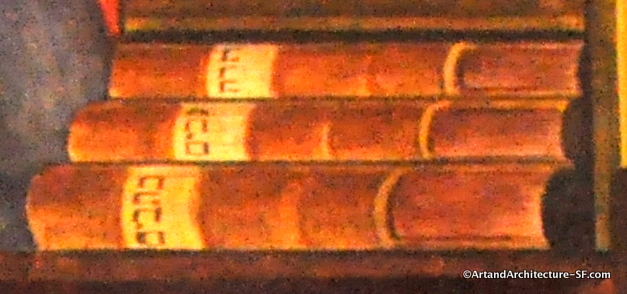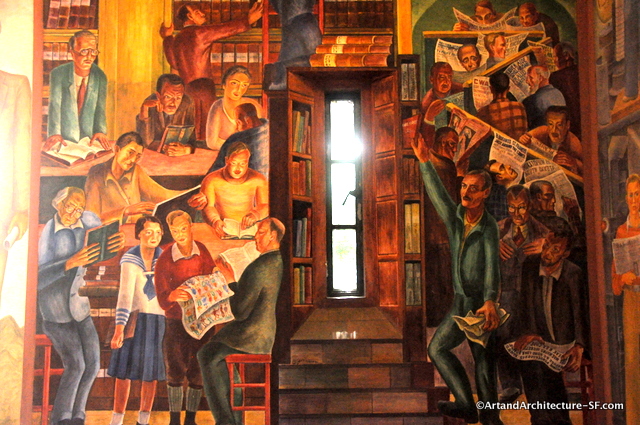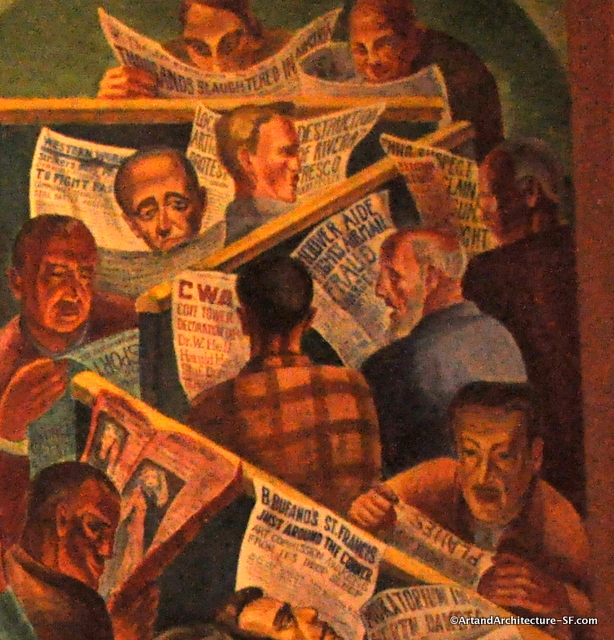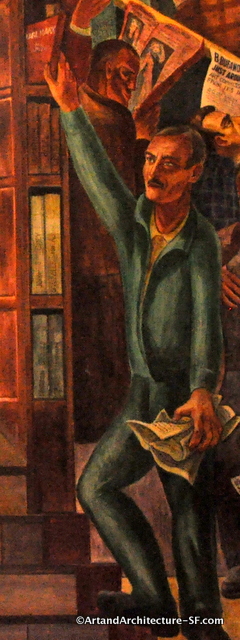The Coit Tower murals were painted during a particularly disruptive period in U.S. History. Depression related economic challenges led to much discussion about alternate forms of government. A four day general strike (Bloody Thursday) accompanied by widespread rioting in San Francisco triggered an eighty-three day 1934 West Coast Waterfront Strike.
Coit Tower muralists protested and picketed at the tower when Rivera’s mural commissioned for Rockefeller Center in New York City was destroyed after he refused to change an image of Lenin in the painting.
The opening of Coit Tower and the display of its murals was delayed several months because of the controversial content of some of the paintings. Clifford Wight’s mural, which contained a hammer and sickle as one of a series of medallions illustrating the range of political philosophies existing in America, was removed before the opening.
This particular mural depicts the anger that the artists felt at the destruction of Rivera/Rockefeller mural and the general tenet of the time.
Ralph Stockpole is reading a headline concerning the destruction of the Diego mural. Col. Harold Mack (on the Washington appointed supervisory committee for the murals) looks on while artist John Langley Howard holds a crumpled newspaper while reaching for Marx’s Das Kapital. Joseph Danysh (later federal Art Project director) holds a paper about mortgage foreclosures. Above the window are three Hebrew letters that spell out the contents of the three books lying on their sides: Torah, Prophets and Wisdom Literature.
 For those of you that are not familiar with the Rockefeller/Rivera controversy, here is a synopsis.
For those of you that are not familiar with the Rockefeller/Rivera controversy, here is a synopsis.
By 1930, Mexican muralist Diego Rivera has gained international favor for his lush and passionate murals. Inspired by Communist ideals and an intense devotion to his cultural heritage, Rivera creates boldly hued masterpieces of public art that adorn the municipal buildings of Mexico City. His outgoing personality puts him at the center of a circle of left-wing painters and poets, and his talent attracts wealthy patrons, including Abby Aldrich Rockefeller. In 1932, she convinces her husband, John D. Rockefeller, Jr., to commission a Rivera mural for the lobby of the soon-to-be-completed Rockefeller Center in New York City.
Flush from successes in San Francisco and Detroit, Rivera proposes a 63-foot-long portrait of workers facing symbolic crossroads of industry, science, socialism, and capitalism. The painter believes that his friendship with the Rockefeller family will allow him to insert an unapproved representation of Soviet leader Vladimir Lenin into a section portraying a May Day parade. The real decision-making power lies with the Center’s building managers, who abhor Rivera’s propagandistic approach. Horrified by newspaper articles attacking the mural’s anti-capitalist ideology, they order Rivera to remove the offending image. When Rivera refuses, offering to balance the work with a portrait of Abraham Lincoln on the opposing side, the managers pay his full fee, bar him from the site, and hide the mural behind a massive drape. Despite negotiations to transfer the work to the Museum of Modern Art and demonstrations by Rivera supporters, near midnight, on February 10th, 1934, Rockefeller Center workmen, carrying axes, demolish the mural. Later, Rivera recreates the frescoes in the Palace of Fine Arts in Mexico City, adding a portrait of John D. Rockefeller, Jr., in a nightclub. Rivera never works in the United States again, but continues to be active, both politically and artistically, until his death in 1957.



I love how SF has so many murals on historical events. Looking at an artistic representation of history makes it more interesting (I think). Really nice one you’ve posted again today!
Great piece of history to go along with this one!
historical murals are great. i am sure this is a stop for school children’s outing.
awesome !
please have a good tuesday.
daily athens photo
Important history is recorded in this mural….wonder how many folks get the message? Thanks for the closeups so we can really see the details.
Terrific post.
Wow! There is something about the blocky style of the people that is very typical of 1930’s art. Thanks for the historic context.
Thank you again for another peek at these frescoes. This last series seems a little sad to me. The figures already look like ghosts of the past. Thank you for this series and for participating in Monday Mural.
I visited San Francisco in 2010 and didn’t make it to Coit Tower. Drats. Fabulous photos of these wonderful images.
With all the libraries in my life I have got to love this one, right?!!